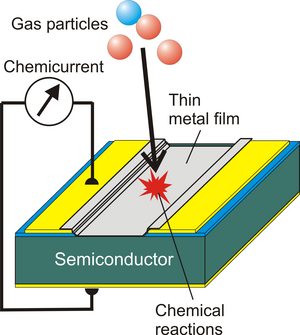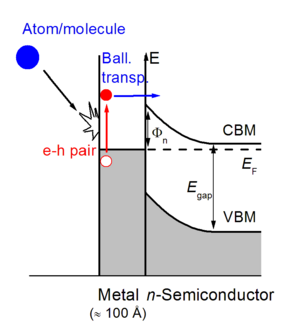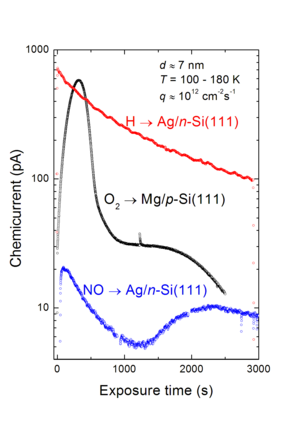Electronic Excitations by Surface Reactions
Chemicurrents or how to detect hot electrons created by chemical reactions?
When chemical or kinetic energy is deposited on metal surfaces by reactions or inelastic scattering the temperature of the metal rises. For a long time, the mechanism of energy-transfer has been believed to be adiabatic, i.e., energy is released directly into the phonon system leaving the metal electrons in the ground state. However, our recent experiments using thin-film electronic devices porve the opposite. Energy dissipation may occur non-adiabatically, i.e., hot electrons and holes may be excited in the metal surface.


To detect the ultrashort living hot charge carriers, the self-made electronic devices are exposed to the reactive gas particles. The detection is schematically demonstrated in Fig. 1 and the principle is explained in Fig. 2 for n-type metal-semiconductor contacts (Schottky diodes). The metal film thickness is in the range of the mean free path of the excited charge carriers. The difference between the Fermi level EF and the conduction band minimum is the Schottky barrier height. If electron-hole pairs are generated at the surface, the hot electron may travel ballistically through the thin metal film, traverse the Schottky barrier, and is detected as a chemicurrent in the diode. This method represents a direct transformation of chemical energy into electricity. The barrier height is typically 0.5 eV in case of Si.

The detected currents are proportional to the reaction rate at the surface. Hence, the observed chemicurrent transients represent the kinetics of the respective surface reaction. This is shown in Fig. 3 for a various chemicurrent transients. The exponential decay of the current during exposure of Ag films to atomic hydrogen is attributed to spontaneous adsorption of the atoms and abstraction of adsorbed hydrogen. The chemicurrent during oxidation of a Mg film on p-Si(111) is described theoretically by a nucleation and growth model indicating that clean Mg surfaces are rather inert to molecular oxygen but as soon as oxide islands exist the oxidation process is promoted. The chemicurrent by interaction of NO with Ag exhibits two maxima which are due to molecular adsorption and intermolecular reactions at the surface.
Current and future experiments try to clarify the excitation mechanisms by investigating
- the isotope effect in H- and D-adsorption on Ag and Al,
- the internal exoemission with very exothermic reactions like Cl2 with Cs,
- the hot charge carrier distribution by varying the homogeneous Schottky barrier height.
The work is supported by the Deutsche Forschungsgemeinschaft within the SFB616. Find out more about chemicurrents and the research of Hermann Nienhaus.
Erfahren Sie mehr: http://www.uni-due.de/ag-nienhaus/index.shtml
